
Sam Gilliam was an American color field painter and lyrical abstractionist artist. Gilliam was associated with the Washington Color School, a group of Washington, D.C.-area artists that developed a form of abstract art from color field painting in the 1950s and 1960s. His works have also been described as belonging to abstract expressionism and lyrical abstraction. He worked on stretched, draped and wrapped canvas, and added sculptural 3D elements. He was recognized as the first artist to introduce the idea of a draped, painted canvas hanging without stretcher bars around 1965. This was a major contribution to the Color Field School and has had a lasting impact on the contemporary art canon.

East 9th–North Coast is a station on the RTA Waterfront Line in Cleveland, Ohio. The station is located west of East 9th Street, south of the Cleveland Memorial Shoreway, and north of the CSX railroad tracks. Entrance to the station is from the west side of East 9th Street. It serves the North Coast Harbor attractions, as well as the northern portion of downtown.

Richard Harned is an American contemporary kinetic sculptor and glass artist. Harned trained under Dale Chihuly in the 1970s at the Rhode Island School of Design (RISD) with other artists of the American Glass Movement, including Bruce Chao and Tom Kreager. In 1974, he established the Abstract Glass studio in Providence, Rhode Island. After graduating from and teaching at RISD, he also taught glass art at Arkansas State University in Jonesboro and the University of Tennessee. He joined the faculty of Ohio State University in 1982.
Craig A. Kraft is an American sculptor. Over the course of his career, Kraft has gained national recognition for his neon light works, establishing him as one of the leading neon sculptors of today. In his earlier works, such as Seated/Unseated Woman and Light Figure Fragment, Kraft rendered sculptures incorporating details in neon. Since 2000, the main focus of Kraft's art has been privately commissioned pieces, such as Connective Ascension, and monumental public art works, such as Lightweb in Downtown Silver Spring, MD, that are abstract pieces made from rolled aluminum and neon tubing.
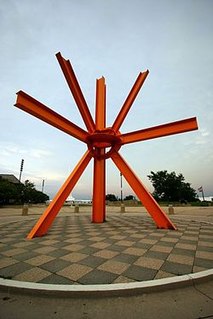
The Calling is a public artwork by American artist Mark di Suvero located in O'Donnell Park, which is on the lakefront in Milwaukee, Wisconsin, United States. The artwork was made in 1981-82 from steel I-beams painted an orange-red color. It measures 40 feet in height, and it sits at the end of Wisconsin Avenue in front of the footbridge that leads to the Milwaukee Art Museum.

Spirit of Commerce is a public artwork by German artist Gustav Haug located in Jackson Park, which is on the south side of Milwaukee, Wisconsin. This zinc sculpture is 15 feet tall and sits on a red granite pedestal near the park's lagoon. It is the oldest public sculpture in Milwaukee.

Stratiformis is a public artwork by Korean-born artist Jin Soo Kim located in Catalano Square, which is south of downtown in the Historic Third Ward of Milwaukee, Wisconsin, United States. The large sculpture combines disassembled knitting machines culled from a local apparel manufacturer in a grid of rusted rebar, all hand-wrapped with galvanized and copper wire. It was installed in 2006.
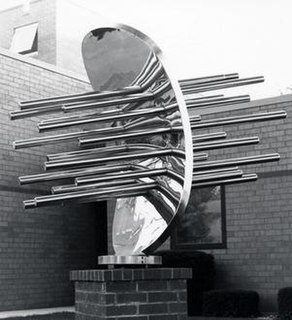
Deflected Jets is a public artwork by American artist Guido Peter Brink located on the Fire Engine Company #29 grounds, which is at 3529 South 84th Street in Milwaukee, Wisconsin in the United States. Commissioned in 1987 and installed the following year, the work consists of a stainless steel abstract form atop a red brick base, to which a placard is affixed. The total size of the piece is approximately 136 by 35 by 35 inches.

The Lapham Memorial is a public artwork by American artist Albert H. Atkins, located near the entrance to Lapham Hall, on the University of Wisconsin–Milwaukee campus. It is in memory of Increase A. Lapham, a 19th-century scientist famous for prompting the creation of the National Weather Service and recording the antiquities of Wisconsin, among other accomplishments.
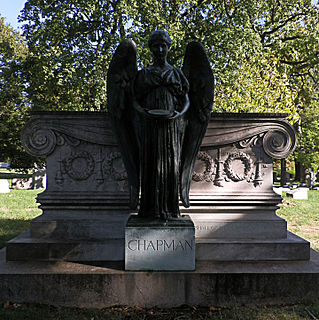
T.A. Chapman Memorial is a public artwork by American artist Daniel Chester French. It is located at 2405 W. Forest Home Ave., in the Forest Home Cemetery Section 33 in Milwaukee, Wisconsin, United States. The bronze sculpture was cast in 1896. Its dimensions are 62 x 41 x 23 in. The concrete base it stands on is 13 ½ x 21 7/8 x 14 3/8 in.
Memorial for Belle Austin Jacobs is a public artwork by American artist Sylvia Shaw Judson (sculptor) and Alexander C. Eschweiler (architect), formerly located in Kosciuszko Park, Lincoln Village, City of Milwaukee, Wisconsin, United States. The statue depicted a young woman kneeling to feed a squirrel. It celebrated the life and philanthropy of Belle Austin Jacobs, who was best known for her work, with her husband Herbert Henry Jacobs, as the founders of organized social work in Wisconsin, including the establishment of the University Settlement House.
Compass is a public artwork by American artist Jon Barlow Hudson, located above the Brady Street Pedestrian Bridge, in Milwaukee, Wisconsin.
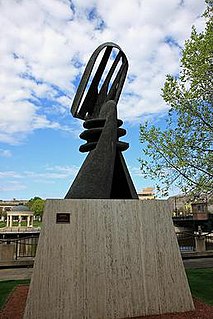
Laureate is a public art work by American artist Seymour Lipton, located on the Riverwalk in downtown Milwaukee, Wisconsin. The abstract artwork was commissioned by the Allen-Bradley Company in memory of Harry Lynde Bradley and as an enhancement for the newly constructed Performing Arts Center. It is located on the east bank of the Milwaukee River at 929 North Water Street.

Kneeling Camels is a public art work by Paul Moulon located at front entrance of the Tripoli Shrine Temple, a civic organization in the Concordia neighborhood west of downtown Milwaukee, Wisconsin. The work consists of two large camels carved from stone. The two sculptures were installed in 1928 at a cost of $10,000.
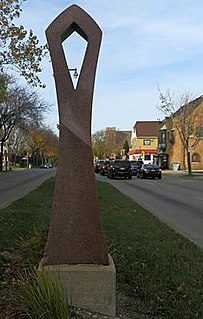
Two Opposites Reaching Up Toward the Peak of Progress is a public art work by American artist Thomas Queoff, located on the south side of Milwaukee, Wisconsin. The granite sculpture is an obelisk made of a narrow piece of red granite cut into a tapering hourglass form. At its base, the sculpture is approximately two feet wide. As the sculpture narrows by a foot toward its midsection, the granite's surface is faceted along a diagonal line. Toward the sculpture's again wider top, a trapezoidal void in the shape of an elongated diamond divides the granite and gives it the appearance of the eye of a needle. The artwork is located in the traffic median on S. Layton Blvd. between W. Greenfield Ave. and W. Orchard St.

The Dauntless Guardian is a public art work by American artist Jeune Nowak Wussow, located on the northwest side of Milwaukee, Wisconsin. The bronze figurative sculpture depicts a child being rescued by a firefighter. It is located at 4141 West Mill Road at Milwaukee Fire Department Engine Company #9.

Buildings 1992 is a public art work by American artist Susan Walsh, located on the northwest side of Milwaukee, Wisconsin. The architectural sculpture was created for the Milwaukee Fire Department station at the intersection of 103rd Street and Fond du Lac Avenue.
Magic Grove is a public art work by artist Nancy Metz White. It is located in Enderis Playfield, which is northwest of downtown Milwaukee, Wisconsin.
Dan Corson is an artist living in Hawaii and is a former member of the Seattle Arts Commission. He works in the field of public art, creating large-scale, concept-driven works installed in urban environments including in parks, railway stations, art galleries, meditation chambers, at intersections, under freeways, and on sidewalks. His approach is a mixture of sculpture, installation, theatrical design, architecture, and landscape design. Media include metal, glass, concrete, fiberglass, gravel, LEDs, lasers, neon, solar panels, radar detectors, photo-voltaic cells, infrared cameras, motors, searchlights, and occasionally elements such as fire, water, and smoke. His work frequently incorporates cutting-edge technology in lighting, sound, and other electronic media.














